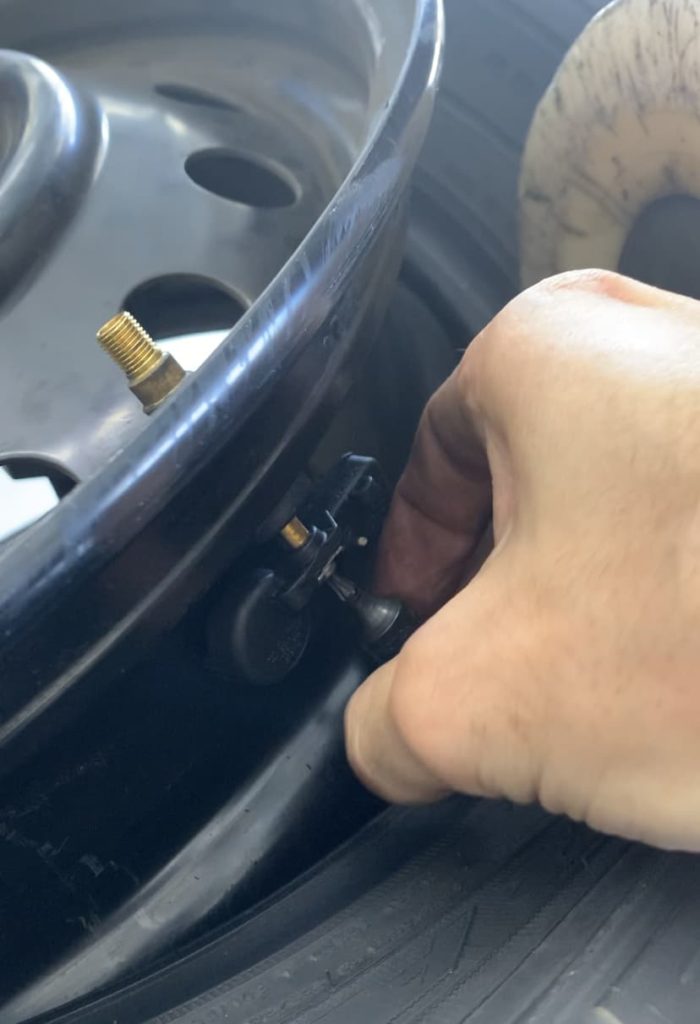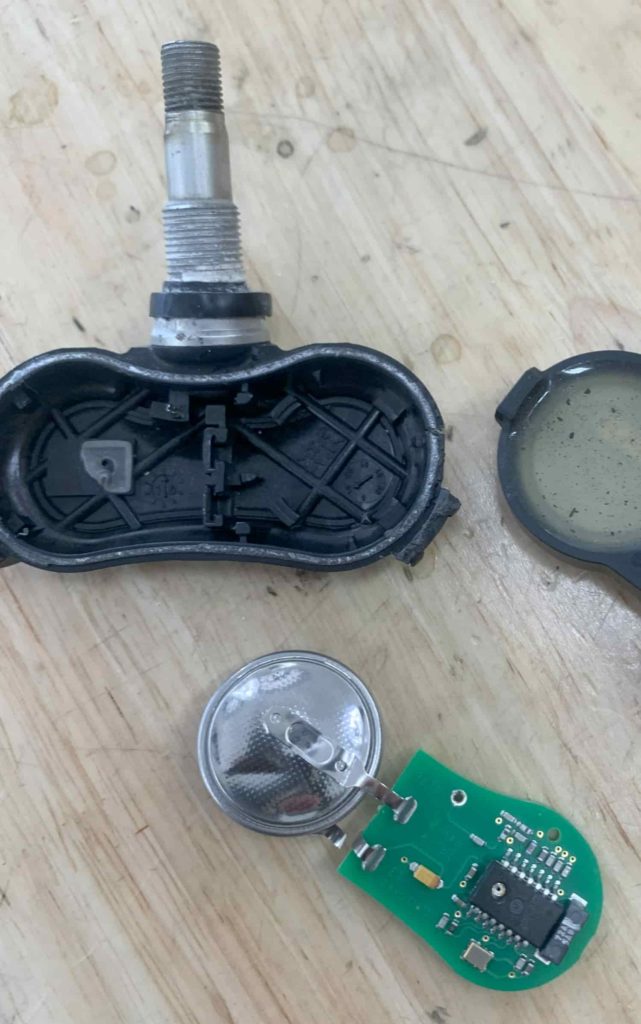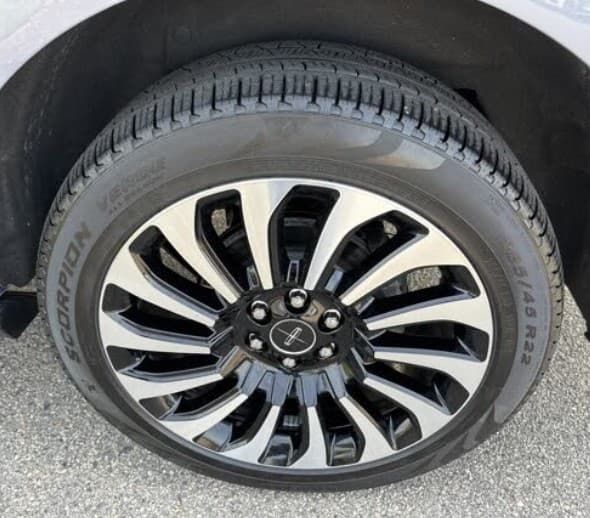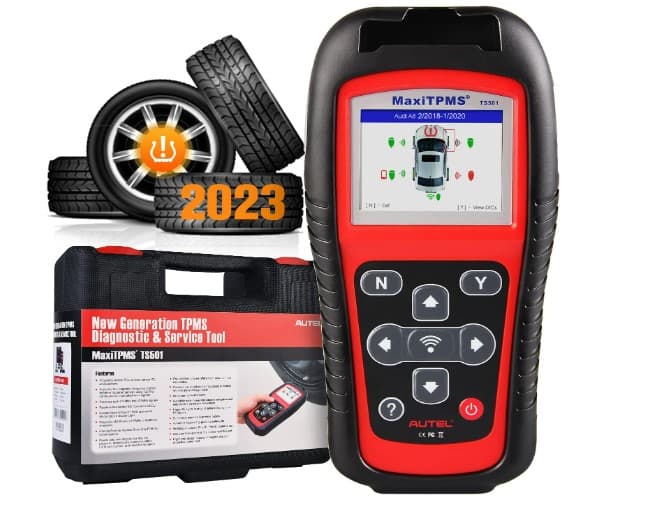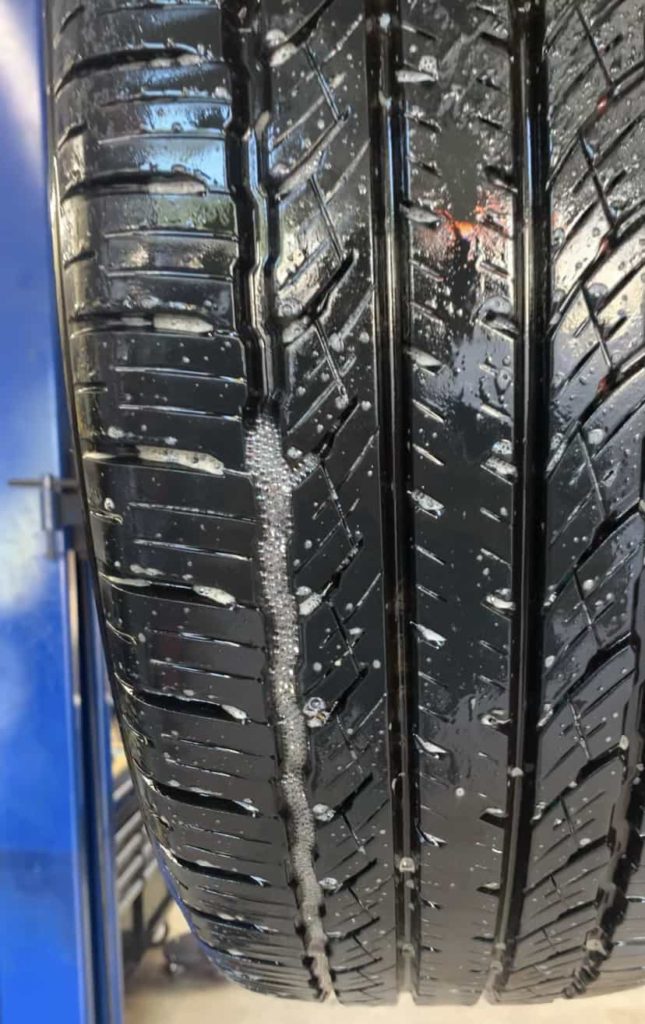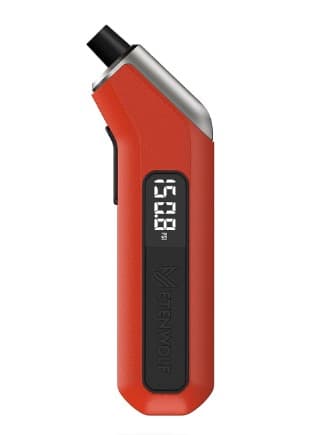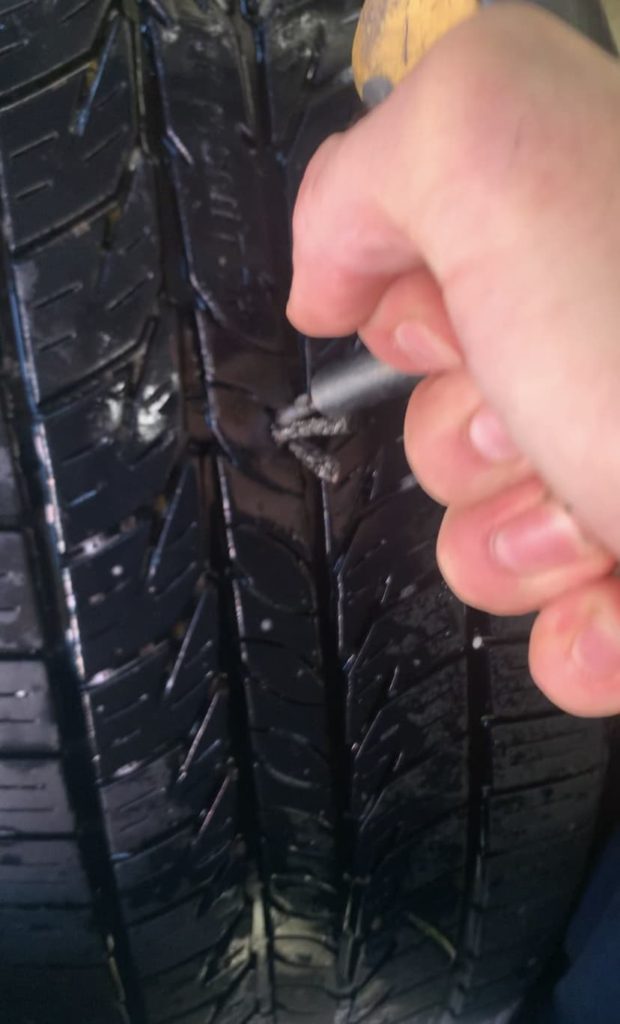What is the Lincoln Navigator TPMS?
The Lincoln Navigator tire pressure light is the final output of the tire pressure monitoring system (TPMS) when either the tires are low on air or the system isn’t working properly. The TPMS is a system made up of three main elements; tire pressure sensors, a TPMS receiver module and the Lincoln Navigator ECM.
How Does the Lincoln Navigator TPMS Work?
Tire Pressure Sensors: Within each tire of the Lincoln Navigator is a tire pressure sensor that is attached to the end of each valve stem. The sensor part is not visible unless the tire is taken off the wheel. Each sensor is responsible for measuring its tires pressure and temperature. Each sensor is essentially a circuit board, a battery, and an antenna that’s enclosed within a small plastic case.
Data/ Information Transmission: Once the Navigator exceeds 20 Mph, the sensors start collecting and sending data. This is done via Radio Frequency (RF) transmission. The Navigator uses both, 315 Mhz and 433 Mhz transmission protocols.
TPMS Receiver Module: TPMS receiver modules are basically another small micro-computer that is located within the SUV. It is responsible for collecting and receiving the information that each tire pressure sensor sends. The TPMS receiver module will check the data for any errors or inconsistencies and then forward it to the ECM.
Lincoln Navigator ECM: The ECM is the main computer and decision maker of the SUV and exists to make sure the Navigator is operating at its best. The ECM processes the data transmitted from the TPMS receiver and determines if the tire pressure and tire temperature values are within an acceptable range. If the pressure values are not within an acceptable range, the ECM triggers a warning light on the dashboard.
Lincoln Navigator Tire Warning: The standard low tire pressure warning light is a yellow exclamation point. The Lincoln Navigator may also display “TIRE PRESSURE LOW”, “TIRE PRESSURE MONITOR FAULT”, or “TIRE PRESSURE SENSOR FAULT”. There are also trailer tire pressure warnings if you are using a trailer with a TPMS kit installed.
Self-Diagnostic Function: The Lincoln Navigator tire pressure monitoring system can also diagnose itself when something isn’t working properly within its system. When there is a communicator issue between sensor, TPMS receiver, or ECM, the tire pressure warning light will flash for about a minute and then stay on until the issue is resolved. This is called a TPMS malfunction.
How to Reset the Lincoln Navigator TPMS?
Park the Navigator on a flat surface.
Inspect every tire to ensure they all appear in good condition.
Gauge and modify the tire pressure to match the cold pressure levels recommended by Lincoln.
Drive the SUV for a short duration (at least a few minutes), making sure to go faster than 20 MPH.
How to Retrain the Lincoln Navigator Tire Pressure Sensors
The Lincoln Navigator tire pressure reset procedure and tire pressure sensor retraining procedure are two different things. The tire pressure sensor retraining procedure should be completed after any type of tire or wheel service/repair, after tire rotations, tire balances or wheel alignments. The main purpose of training/retraining the tire pressure sensors is so that the Lincoln Navigator ECM knows which tire is where on the vehicle and is reporting the proper information to the main information display screen. For example, after a tire rotation, the front wheels go to the rear and the ECM needs to be reprogrammed to know this.
Engine Shutdown: Shut off the Lincoln Navigator Engine.
Electricity On, Engine Off: Swiftly tap the start button twice, avoiding the brake pedal, or rotate the key to the ACC position. The aim is to power up the electrical system without starting the engine.
Operate Hazard Lights: Engage the hazard flashers by toggling the button on and off 3 times, resulting in a total of six clicks. On-Off, On-Off, On-Off.
Initiate Reset Procedure: If steps 1-3 are executed accurately, a single horn beep and a “RESET MODE” screen alert will confirm that the SUV is in a reset state.
Front Left Tire: Exit the SUV and unscrew the valve cap on the driver’s side front tire.
Deflate Front Left Tire: Depress the valve core to let out air until the horn beeps, signifying the tire’s position is acknowledged.
Front Right Tire: Approach the front right tire (passenger side front), remove its valve cap, and deflate it until you hear the horn beep.
Rear Right Tire: Proceed to the back right tire (passenger side rear), remove the valve cap, and release air until the horn beeps.
Rear Left Tire: Lastly, go to the driver’s side rear tire, take off its valve cap, and let air out until you hear the horn beep.
Training Completion: A “Training Complete” alert will appear on the information display screen upon successful execution of steps 1-9.
Reinflate Tires: Inflate all the tires back up to the recommended pressure.
Take a Drive: Drive the Lincoln Navigator for at least 2 minutes while maintaining a speed above 20 mph.
Lincoln Navigator Tire Pressure Sensor Retraining Tips
💡 Should you not hear a horn beep after the third step is done, turn the power off, go for a quick drive, and start the process over again.
💡 It’s crucial to follow the specified sequence of reset steps for the Lincoln Navigator. (LF tire, RF tire, RR tire, LR tire)
💡 If two horn beeps are made at anytime while following this process, start over.
How to Change the Lincoln Navigator Tire Pressure Units
Select the Settings button on the right side of the steering wheel
Select DISPLAY SETUP.
Select TIRE PRESSURE
How to View the Lincoln Navigator Current Tire Pressures
Use the OK button on the steering wheel
Toggle Up or Down to view current tire pressures.
2023 Lincoln Navigator Tire Pressures
TIRE SIZE | FRONT PSI | REAR PSI |
275/55R20 | 39 | 39 |
285/45R22 | 39 | 39 |
3 Different Lincoln Navigator Tire Pressure Warning Messages
"TIRE PRESSURE LOW"
This alert signifies that at least one tire is underinflated and requires inflation to meet the recommended pressure levels.
"TIRE PRESSURE MONITOR FAULT"
This alert implies that an issue or malfunction within the tire pressure monitoring system is causing the low tire pressure light to blink.
"TIRE PRESSURE SENSOR FAULT"
This alert signifies that a minimum of one tire pressure sensor is failing to establish successful communication with the TPMS receiver module or Lincoln Navigator ECM.
What Can Cause the Lincoln Navigator Low Tire Pressure Light to Turn On?
Tires with low air pressure
Overinflated tires
Tires experiencing air loss
Absence of sensor in the wheel (such as when using a spare)
Drained or defective TPMS sensor battery
Malfunction or faulty TPMS receiver or central computer (ECM)
Nearby electronic devices or similar vehicle models causing radio frequency interference
Fluctuations in weather or elevation
Excessive vehicle load
Use of tire chains
Thick window tinting
Lincoln Navigator Tire Pressure Sensor Batteries
Each tire on a Lincoln Navigator, except for the spare, comes with its own individual tire pressure sensor. Each TPMS sensor is essentially made up of a tiny circuit board, a transmitter/antenna, and a small battery made of silver oxide. The batteries are similar looking to those found in wrist watches or key fobs. The sensor’s circuit board is directly connected to the battery. Due to the integrated design, when the battery’s life runs out, you can’t simply replace or recharge it; instead, you’ll need to replace the whole sensor and the valve stem it’s attached to. Generally, the lifespan of these sensors in a Lincoln Navigator varies between 5 and 10 years, or roughly up to 150,000 miles.
Diagnosing Low Tire Pressure Light Problems in the Lincoln Navigator
Occasionally your Lincoln Navigator tire pressure light will turn on and resetting the TPMS or retraining the tire pressure sensors won’t get the tire light to turn off. We know this is frustrating! We have come up with 6 possible scenarios and solutions for this situation below:
SOLUTION 1: IS A TIRE EXPERIENCING LOSS OF AIR PRESSURE?
When the tire pressure warning illuminates, your first action should be to find out why. Are all the tires low on air? – This would likely be from weather or natural air loss. Is one tire low on air but the other 3 are fine? Inspect each tire and wheel closely as you walk around your Navigator. Then, proceed with the following procedures:
Rather than solely relying on the onboard tire pressure system, manually gauge the air pressure in each tire to identify the underinflated one.
Use a tire inflator to adjust and rectify the tire pressures. Ensure you recheck the pressure after inflating for accuracy.
Drive the Lincoln Navigator at speeds above 20 Mph for several minutes.
⏩CONCLUSION: If the low tire pressure indicator turns off after you’ve inflated the tires and driven the Navigator, but comes back on later – be it seconds, minutes, or days afterward – there’s a high likelihood of an air leak in your tire or wheel. To pinpoint the exact leakage point on the wheel or tire, refer to solution 6 below.
SOLUTION 2: CLEARING THE DIAGNOSTIC TROUBLE CODES (DTC) FROM THE LINCOLN NAVIGATOR
Similar to when your computer freezes and you unplug it or restart it, you can do the same with the Lincoln Navigator computer system. The Lincoln Navigator computer, also known as the ECM or ECU, is constantly recording all the information the SUV’s sensors are sending it. The ECU/ECM has threshold ranges for what the sensor’s data should be. If the data it receives is below or above the range, it sets off a warning light to alert the driver (a DTC or Diagnostic Trouble Code) that something is wrong. This is what happens when the low tire pressure light turns on. Everytime the computer sees a DTC, it records it and stores it in its memory as a temporary or permanent DTC. Just like your laptop, ECM’s can glitch and need to be rebooted when nothing else seems to be working, to reboot your Lincoln Navigator ECM and erase the temporary DTC’s, follow these steps:
Manually check and set the tires to the correct cold pressure values.
Turn the engine off and all power to the Navigator off. (lights, radio, etc..)
Detach the negative terminal of the primary 12-volt battery.
Pause briefly.
Reconnect the negative battery terminal to restore power.
Drive the Navigator at a steady 50 Mph for approximately 30 minutes.
⏩ ANSWER: After you disconnect and reconnect the Navigator battery, the tire pressure light will turn off, but does it turn back on after driving? If the low tire light does turn back on, it means you either had a tire that’s losing air from a leak of some kind or the ECM is not communicating properly with a tire pressure sensor. If you have ruled out a tire leak, go to the next solution to diagnose the tire pressure sensors.
SOLUTION 3: USING A TPMS PROGRAMMING TOOL TO DIAGNOSE THE LINCOLN NAVIGATOR TIRE PRESSURE SENSORS
If after implementing steps 1 & 2 you suspect a malfunctioning tire pressure sensor, a TPMS programming device is necessary. Personally, I’ve trusted the Autel TPMS diagnostic devices for a long time and can vouch for their reliability and accuracy. To determine which tire pressure sensors are not functioning optimally, test each one using a TPMS programming tool. This is how it works:
Connect the TPMS programming tool to the Lincoln Navigator’s OBD2 port under the steering wheel.
Follow the tool’s prompts to begin testing the tire pressure sensors.
Position the TPMS programming tool directly in front of the valve stem of the front driver-side tire and select the “trigger” or “test” button on the device.
Give it a moment, and the device will provide feedback.
Repeat this process for the remaining 3 tires, Be sure to follow the tool’s instructions in the correct order.
⏩ OUTCOME: After assessing each tire pressure sensor, the TPMS programming device will generate an overview of the health of each sensor. If the programming tool and tire pressure sensor cannot communicate or if the tool says a sensor’s battery is low or depleted, that tire pressure sensor needs to be replaced.
SOLUTION 4: REVIVING AN INACTIVE TIRE PRESSURE SENSOR
Tire pressure sensors can become dormant which causes a low tire pressure light. To try to awaken or activate a tire pressure sensor follow these steps:
Press the valve stem in to release air from the problematic tire pressure sensor.
Deflate the tire by 15-20 Psi.
Re-inflate the tire back up and add an additional 5 Psi. If the tires recommended pressure is 35 Psi, inflate it to 40 Psi. (temporarily)
Drive the Lincoln Navigator for a few minutes while exceeding 20 Mph. (do not go on the highway or at excessive speeds.)
Park the SUV and release the extra 5 Psi to set the pressure to the recommended levels.
⏩ WHAT TO KNOW: If you are having issues either resetting or re-training your Navigator tire pressure sensors, use this solution before attempting the tire pressure sensor retraining sequence.
SOLUTION 5: INTERMITTENT AVTIVATION OF THE TIRE INDICATOR LIGHT
If you reside in areas with significant overnight temperature drops or where the seasons bring temperature fluctuations, you might have noticed the low tire pressure indicator illuminating upon starting your Lincoln Navigator in the morning. However, as the day progresses, temperatures rise, and tires warm up, the warning light deactivates without you doing anything. Such occurrences are typical but preventable.
⏩ WHAT TO DO: Always ensure you calibrate and set your tire pressures when they are in a cold state. Specifically, when the Lincoln Navigator hasn’t been in use for a minimum of 3 hours or has been driven under a mile. Adopting this practice guarantees accurate tire pressure adjustments.
SOLUTION 6: IDENTIFYING A TIRE'S AIR LEAK POINT
If you’ve gone through these solutions and have come to the conclusion that you have a tire leaking air, this is how you find out where it’s leaking from.
What You Need: Water, Soap/windex, spray bottle, tire pump.
Fill up the tire air pressure to at least 35 Psi.
Mix the water and soap in the spray bottle and mix it up. You can use a solution such as windex for this also.
Position the wheel on the Navigator so that you can spray it down easily. – if it’s a front tire, turn the steering wheel so you can see more of the tire.
Spray and soak the tire with the soapy water mix.
Examine the tire while it’s soaked for small bubbles of air.
⏩ ANSWER: The bubbles on the tire pinpoint the exact location of where the tire is leaking air from. Mark the puncture location with chalk so you can locate it for repair.
Lincoln Navigator Tire Pressure
How a 10 Degree Drop in Temperature Affects the Lincoln Navigator's Tires
For every 10°F drop in air temperature, tire pressure will decrease by approximately 1-2 Psi. This means that in places where temperature fluctuations are significant, such as a 25-degree drop from midday to early morning, the tire pressure in a Lincoln Navigator could potentially drop by about 2.5-5 Psi. This is a very common occurrence and is often a main cause for the low tire pressure light to turn on.
How to Check the Lincoln Navigator Tire Pressure
Locate the Specifications: Find the recommended tire pressure for your Lincoln Navigator. It’s displayed on a white or yellow sticker inside the driver-side door jamb.
Gather Tools: We recommend using a digital tire pressure gauge because they are accurate and easy to use.
Prepare the Vehicle: Ensure the Navigator is parked on a flat surface and has been stationary for at least three hours, or if it has been driven, no more than a mile. This ensures the tires are “cold” for an accurate reading.
Measure the Pressure: Remove the valve cap from one tire. Firmly press the tire gauge onto the valve stem and record the reading.
Compare and Adjust: If the measured pressure differs from the recommended value, either inflate the tire using an air compressor or release some air until it matches the specification.
Repeat: Check the remaining three tires.
Valve Cap: Don’t forget to put the valve caps back on!
Common Lincoln Navigator Tire Pressure Questions
Can You Disable the Lincoln Navigator Tire Pressure System?
No. Any modifications made to the Lincoln Navigator tire pressure system will result in the low tire pressure light malfunctioning.
What Should You Do With the Tire Pressure Sensors When You Replace Wheels or Tires?
If you replace the tires on your Lincoln Navigator the only thing you need to do is retrain the tire pressure sensors. If you replace the wheels or rims on your Lincoln Navigator you have two options; either swap the old tire pressure sensors from the old wheels to the new wheels OR purchase a new set of 4 tire pressure sensors, install them on the new wheels and then program them to the Navigator ECM using a TPMS programming tool.
Does Altitude Affect the Lincoln Navigator Tire Pressure?
Altitude plays a notable role in the tire pressure of the Lincoln Navigator. For every 1,000 feet increase above sea level you drive, the atmospheric pressure drops by about 3.5% which can cause the tire pressure to increase by about 1 Psi. This means that if you are driving up a mountain and the altitude increases by 4500 feet, the tire pressure will increase by about 4.5 Psi.
Is it Safe to Drive the Lincoln Navigator With the Tire Light On?
No it is not safe to drive the Lincoln Navigator with the low tire pressure light on. The TPMS light turns on for a reason, it means something is wrong. Whether you have low tire pressure or a tire pressure sensor not communicating with the SUV’s ECM, you need to determine the cause before continuing to drive. Stop driving and manually inspect and check the tire pressures.
Why is the Lincoln Navigator Tire Light Flashing?
When the tire light on the Lincoln Navigator flashes, this means the tire pressure monitoring system is malfunctioning. This will occur when the Lincoln Navigator TPMS receiver module or ECM are not communicating properly with one or more tire pressure sensors. This will often happen when driving with the spare tire on because it does not have a tire pressure sensor in it or when the battery is low or dead in a TPMS sensor. We recommend using Solution 3 above if you experience these issues.
Can You Trust Tire Plugs?
Yes, tire plugs are a great way to repair a puncture on the tread of a tire. Do not use them if the tread is completely worn or on the sidewall of a tire.
Will Tire Sealants Damage the Lincoln Navigator Tire Pressure Sensors?
Tire sealants can not only damage the tire pressure sensor but also cause the tire to become out of balance. We suggest only using a tire sealant in an emergency situation.
Everything in this article is applicable to all Lincoln Navigator models and versions including the Lincoln Navigator Premiere, Reserve, Reserve L, and Black Label.
Please note that this blog post contains Amazon affiliate links. This means that if you make a purchase through one of these links, we at TPMSRESET.COM may earn a small commission at no extra cost to you. We only recommend products that we personally use and believe in. Thank you for supporting us.

